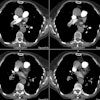Radiology 1997 Jul;204(1):157-163. Peripheral pulmonary arteries: optimization of the spiral CT acquisition protocol.
Remy-Jardin M, Remy J, Artaud D, Deschildre F, Duhamel A
PURPOSE: To analyze the influence of collimation on identification of segmental and subsegmental pulmonary arteries on spiral computed tomographic (CT) scans. MATERIAL AND METHODS: Contrast material-enhanced spiral CT scans were retrospectively analyzed. Patients in group A (n = 20) underwent CT with 3-mm collimation, 1.00 second per revolution, and pitch of 1.7; those in group B (n = 20) underwent CT with 2-mm collimation, 0.75 second per revolution, and pitch of 2.0. A total of 800 segmental (20 arteries per patient) and 1,600 subsegmental (40 arteries per patient) arteries were assessed. RESULTS: The mean number of analyzable segmental arteries per patient was greater in group B patients (18.6 of 20.0 [93%]) than that in group A patients (17.0 of 20.0 [85%]) (P < .001). The mean number of analyzable subsegmental arteries per patient was greater in group B patients (24.6 of 40.0 [61%]) than that in group A patients (14.8 of 40.0 [37%]) (P < .0001). Frequency of identification on CT scans of 13 of the 40 subsegmental arteries was improved in group B compared with group A patients (P < .0001). CONCLUSION: Spiral CT with 2-mm collimation at 0.75 second per revolution enables marked improvement in the analysis of segmental and subsegmental pulmonary arteries.
PMID: 9205239, MUID: 97349235







